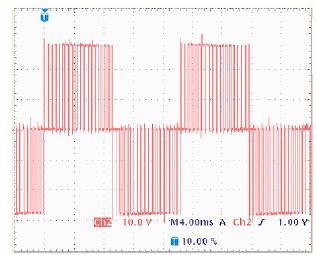ABSTRACT
In
this paper a XILINX FPGA based multilevel PWM single-phase inverter was
constructed by adding a bi-directional switchs to the conventional bridge
topology. The inverter can produce three and five different output voltage
levels across the load. XILINX FPGA is a programmable logic device developed by
XILINX which is considered as an efficient hardware for rapid prototyping. It
is used as a PWM generator to apply the appropriate signals to inverter
switches. In addition to XILINX FPGA, Matlab/Simulink software was used for
simulation and verification of the proposed circuit before implementation,
Simulation and experimental results show that both are in close agreement.
SOFTWARE: MATLAB/SIMULINK
CIRCUIT
DIAGRAM:
Fig.1 The proposed circuit of the multilevel PWM single phase
inverter
EXPECTED SIMULATION AND EXPERIMENTALRESULTS:
Fig.2.Multilevel PWM
single phase simulation results using XILINX FPGA at Ma = 0.8.
Fig.3 Multilevel PWM
single phase simulation results using XILINX FPGA at Ma = 0.4.

Fig.4 Multilevel single-phase PWM at Ma=0.8 Simulated, (b)
Experimental
Fig.5 Multilevel single-phase PWM at Ma=0.4 (a) Simulated,
(b) Experimental
Fig.6.Unfiltered output voltage five levels at Ma=0.8
Fig.7 Unfiltered output voltage five levels at Ma=0.4
Fig.8. Ac voltage waveform before and after the filter in the proposed multilevel PWM inverter at modulationindexes (a) 0.8 and (b) 0.4.
Fig.9.Ac voltage and current output
waveforms for
resistive load.
Fig.10 Ac voltage and current output
waveforms for (resistive- inductive) load.
Fig.11Ac voltage output harmonic spectral after filter
CONCLUSION
The switching patterns adopted are applied at the six inverter
switches to generate five or three output voltage levels at different
modulation indexes. XILINX FPGA enables to make easy, fast and flexible design
and implementation. The experimental and simulated results are show
satisfactory results in term of total harmonic distortion and output voltage
and current waveform shapes.
REFERENCES
.
[1] V.G.Agelidis, D.M.Baker, W.B.Lawrance and C.V. Nayar “ AMultilevel
PWM Inverter Topology for Photovoltaic Applications” IEEE.ISIE’97,Guimaräes,
Portugal, pp.589-594, 1997.
[2] J.S. Lai and F.Z.Peng,
”Multilevel converters –A new breed of power conversion ” IEEE Trans. 1nd.
Applicat., vol.32, pp. 509-517, May/June. 1996.
[3] N.S. Choi, J.H. Cho, and G.H. Cho, “A General circuit Topology of
Multilevel Inverter” IEEE Trans. Power Electronics, vol. 6,
pp.96-103, 1991.
[4] E. Cengelci, S. U. Sulistijo, B. O. Woom, P. Enjeti, R.
Teodorescu, and F. Blaabjerge,“A new medium voltage PWM inverter topology for
adjustable speed drives” in Conf. Rec. IEEE-IAS Annu. Meeting, St. Louis
MO, pp.1416-1423, Oct.1998.
[5] B. N. Mwinyiwiwa,
Z.Wolanski, and B. T. Ooi, “Microp- rocessor implemented SPWM for
multiconverters with phase-shifted triangle carriers” in Conf. Rec IEEE-IAS
Annu. Meet- ing, NewOrleans, pp. 1542–1549, Oct. 1997.
































